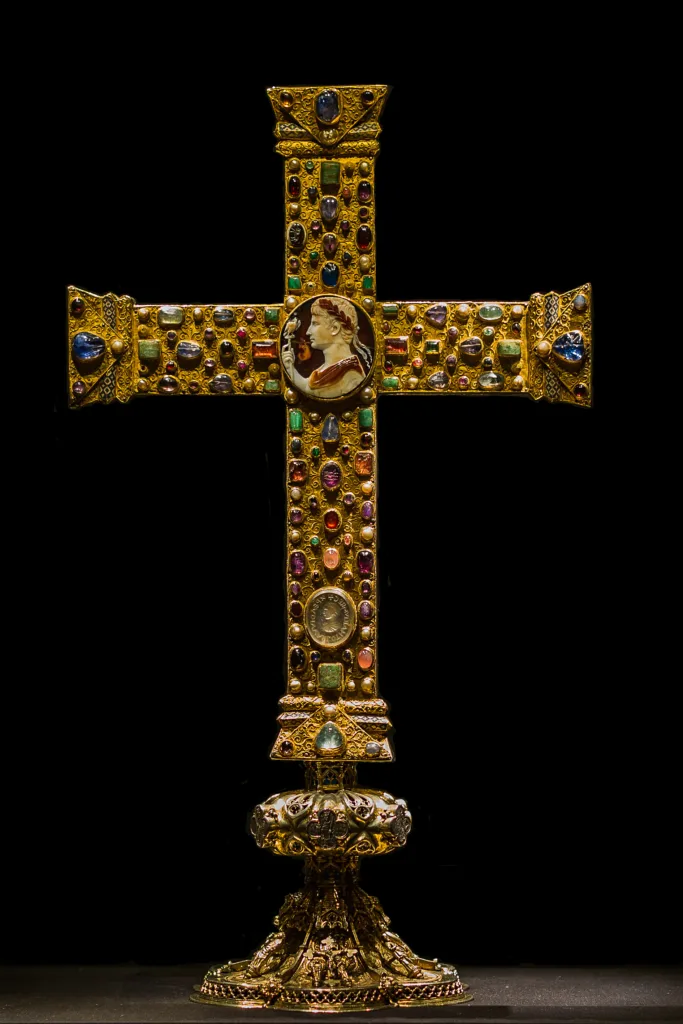The Lothair Cross is a remarkable work of art that dates back to the medieval era. Created around the year 1000 A.D., this wooden cross is covered with gold, precious stones, and pearls, making it a stunning example of medieval goldsmith’s work. The cross is still used in processionals today, and is considered an important monument of imperial ideology.
The core of the Lothair Cross is made of oak, which is encased in gold and silver and adorned with jewels and engraved gems. In total, the cross features 102 gems and 35 pearls, all of which are carefully arranged to create a beautiful, intricate design.
The front of the cross is made of gold and silver plate and is richly decorated with precious stones, pearls, gold filigree, and cloisonné enamel. The craftsmanship on display is truly remarkable, and it’s clear that the artisans who created the Lothair Cross were true masters of their craft.
One of the most interesting features of the Lothair Cross is the cameo of Augustus in the center of the cross. The cameo is made of sardonyx and had been passed down from the Carolingians and the Ottonians. By including Augustus’s portrait on the cross, the creators of the Lothair Cross were attempting to link themslves to the ancient Roman Empire and its legacy of power and influence.
Today, the Lothair Cross is housed in the Aachen Cathedral Treasury, along with several other masterpieces of sacral Ottonian art. It continues to be a valued and revered part of the cathedral’s collection, and is a testament to the incredible skill and artistry of medieval craftsmen.
The Lothair Cross is a truly remarkable work of art that has stood the test of time. Its intricate design, use of precious materials, and historical significance make it a valuable and important piece of medieval art, and a testament to the skill and creativity of the artisans who created it.
What Was The Cross Of Lothair Used For?
The Cross of Lothair, also kown as the Lothair Cross, was created in the year 1000 A.D. It is a wooden cross that is covered with gold, precious stones, and pearls. The cross was used in processionals and is still used in religious ceremonies today. The purpose of the Cross of Lothair was to serve as a symbol of the Christian faith and to honor the memory of Emperor Lothair I, who ruled from 817 to 855 A.D. The cross is considered to be one of the most important pieces of art from the medieval period due to its intricate design and the use of precious materials. It is also a significant artifact in the history of Christianity and is revered by people of the faith around the world.

What Is The Cross Of Lothair Made Of?
The Lothair Cross is primarily made of oak wood, which serves as its core. However, it is encased in precious metals such as gold and silver, and adorned with an array of jewels and engraved gems. In total, there are 102 gems and 35 pearls that make up the intricate design of the cross. The front of the cross, which is the main focus in this context, is composed of gold and silver plate that is richly decorated with precious stones, pearls, gold filigree, and cloisonné enamel.
What Type Of Art Is The Cross Of Lothair?
The Cross of Lothair is a remarkable example of medieval goldsmith’s work and is considered as one of the most significant works of sacral Ottonian art. It is an important monument of imperial ideology and is crrently housed in the Aachen Cathedral Treasury, along with other exceptional masterpieces of the same period. The art piece is crafted from gold, precious stones, and pearls. The cross features intricate filigree work and cloisonné enamel, which were popular techniques used in goldsmithing during the Ottonian period. Its design is a depiction of the Crucifixion of Christ, and it also features scenes from the Old Testament. the Cross of Lothair is a valuable and notable piece of medieval art that showcases the exceptional skills of goldsmiths during the Ottonian period.
Who Is On The Center Of Lothar Cross?
The center of the Lothar Cross features a portrait of Augustus, a prominent figure in Roman history. The portrait is depicted on a sardonyx cameo, which has been passed down from the Carolingians and the Ottonians. The inclusion of Augustus’s portrait on the Lothar Cross suggests an attempt to link the cross and its legacy to the history and prestige of the Roman Empire.
Conclusion
The Lothair Cross is an exceptional example of medieval goldsmith’s work and an important monument of imperial ideology. This wooden cross covered with gold, precious stones, and pearls dates back to approximately 1000 A.D. and is still used in processionals today. The front of the cross is made of gold and silver plate and is richly decorated with precious stones, pearls, gold filigree and cloisonné enamel. The cameo of Augustus in the center of the cross further emphasizes the link between the Ottonians and the Carolingians. The Aachen Cathedral Treasury, where the Lothair Cross is housed, contins several other masterpieces of sacral Ottonian art. the Lothair Cross is an outstanding work of art and a testament to the skill and craftsmanship of medieval goldsmiths.
